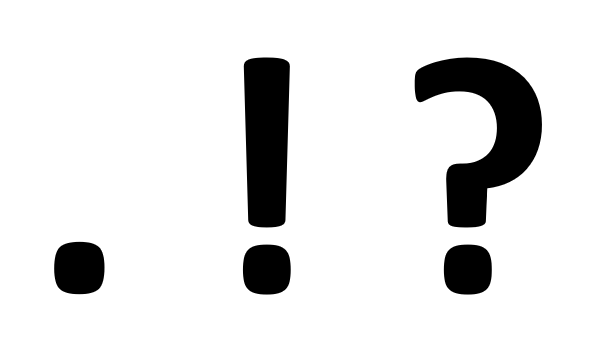- 3-minute read
- 26th March 2018
Terminal Punctuation
The phrase ‘terminal punctuation’ sounds rather dramatic (as if somebody has died from excessive comma usage). However, it’s actually a catch-all term for punctuation that goes at the end of a sentence. In this post, then, we’re going to look at three key terminal punctuation marks.

The Full Stop.
The full stop (or ‘period’ if you’re American) indicates the end of a sentence. This, along with capitalising the first letter of the next word, helps us see where one sentence ends and another begins.
This is the most basic form of terminal punctuation, so you should use a full stop at the end of any sentence that isn’t a question or an exclamation.
The same punctuation mark is also used in some abbreviations (e.g. ‘ibid.’), decimals (e.g. ‘1.45’) and to form ellipses (i.e. three dots that indicate an omission). But it only counts as terminal punctuation at the end of a sentence.
The Exclamation Point!
The exclamation point is the most excitable punctuation mark. It should only be used if you’re trying to express intense emotions, surprise or alarm. Like the full stop, it goes at the end of a sentence.
Exclamation points are very rare in formal or academic writing. You can use them more in other types of writing, but you shouldn’t overdo it. Using too many exclamation points can seem like you’re trying too hard to make something sound exciting, which explains why F. Scott Fitzgerald said:
One should never use exclamation points in writing.
It is like laughing at your own joke.
A little harsh. But he was a good writer, so we should listen to him.
Find this useful?
Subscribe to our newsletter and get writing tips from our editors straight to your inbox.

The Question Mark?
The last of the ‘Big Three’ in terminal punctuation is the question mark. As the name suggests, we put this at the end of a sentence (instead of a full stop) to show that it’s a question.
One thing to remember is that this only applies to direct questions (i.e. questions posed as requiring an answer). You should not use a question mark with an indirect question (i.e. a statement that reports or contains a question). For example:
Direct Question: She asked, ‘Where is the ice cream?’
Indirect Question: She asked me where the ice cream is.
Both of these communicate the same information, but only the first includes a direct question.
With rhetorical questions, meanwhile, the question mark is optional.